Old Forgotten Farr
Poor old Farr, long gone and damn near forgotten.
If you read my previous blog post[1] , you read about Farr’s Law of Epidemics, which says that epidemics tend to rise and fall in a roughly symmetrical pattern or bell shaped curve.[2]
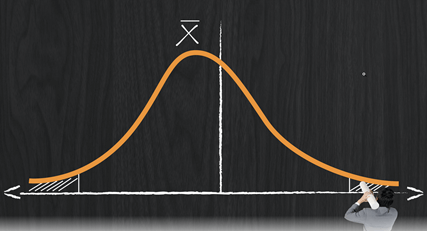
I can’t find any information on Mr. Farr, but his law was first formulated in 1840. It has been ignored in every epidemic since[3], which is not surprising given our penchant for forgetting the lessons and wisdom of the past. I believe it is particularly applicable regarding the spread and eventual reduction of Coronavirus cases.
Below is a graph of the number of new daily cases in China.[4] As you can see, they have followed the typical Farr’s Law pattern. (The huge spike in mid-February represents a latent recognition of past cases.)
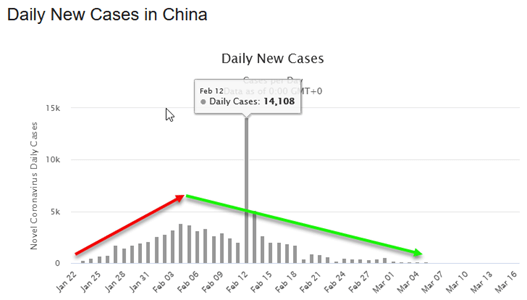
Where do the other countries hardest hit by the disease currently stand? The pattern in South Korea looks very similar to China. (If you’re skeptical of Chinese reporting on this, the Korean data is reassuring.) South Korea peaked and dropped so quickly because they were able to extensively test, track contacts and quarantine.[5]
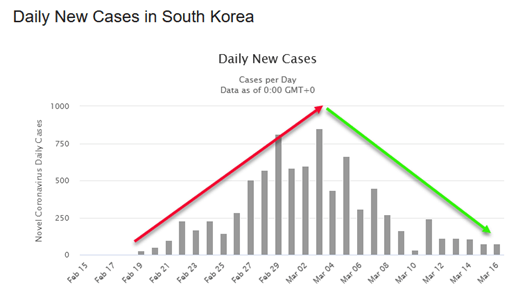
Iran may have peaked, though their information could be tainted for propaganda purposes.
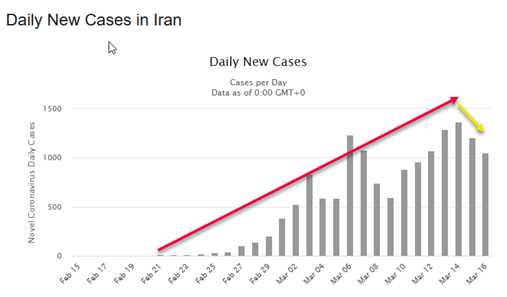
Italy, Spain, France, Germany and the United Kingdom are still rising.
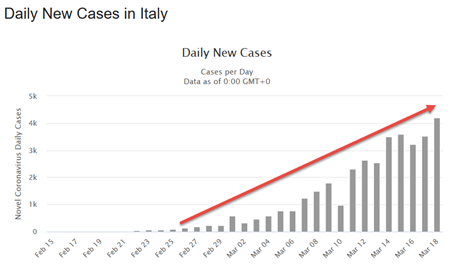

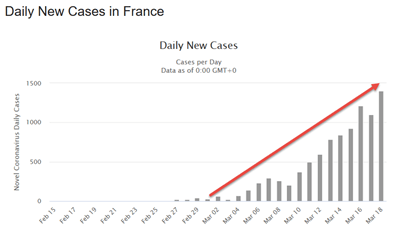
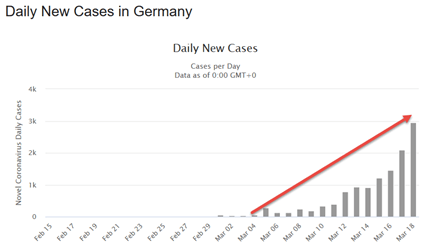
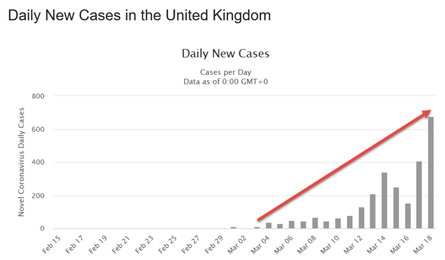
Where does the good ol’ U.S. of A. stand? At the moment, daily new cases are still rising, though in spite our larger population, we have significantly fewer cases.
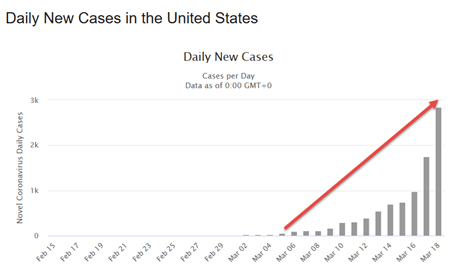
Bottom Line – Based on the experiences of China and South Korea, there is no reason to believe that Farr’s Law has been repealed. Cases in other countries, including the U.S., should start to follow this same pattern.
Temperature Effect Update
In my blog post of 3/17/20[6] , I cited a paper which hypothesized that, because most of the current cases have occurred above 30 degrees north latitude, the coronavirus will probably dissipate – much like the seasonal flu –as the warmer, more humid weather of summer arrives in the northern hemisphere. Chinese researchers have done additional work supporting this theory:[7]
Using the daily R values from January 21 to 23, 2020 as proxies of non-intervened transmission intensity, we find, under a linear regression framework for 100 Chinese cities, high temperature and high relative humidity significantly reduce the transmission of COVID-19, respectively, even after controlling for population density and GDP per capita of cities.
Though we should be rightly skeptical of a good deal of the information that comes from communist China, I can’t think of any reason that they would gin up this kind of work for propaganda purposes.
We’ve Been Here Before
I was just out of diapers in the fall of 1957, so I have no recollection of the Asian Flu that struck the U.S. in the fall of that year. Mom’s not here so I can’t ask her if I got it, but it’s likely that I did, since it was highly contagious. And deadly: it was estimated to have caused 60,000 deaths.[8] What was the effect on the economy and the market? GDP took a significant hit in the 1st quarter of 1958. But the market selling panic (a 25% decline in the Dow Jones Industrial Average) ended in October of ’57. It was already over by the time GDP turned down. After that, stocks traded in a narrow range for 5 months, and then the Dow broke out and climbed nearly 50% over the next 15 months.
There is, of course, no guarantee that history will repeat itself, but the doomsters couldn’t be more wrong when they say we are in uncharted waters.
Don Harrison
3/19/20
The information contained in this report does not purport to be a complete description of the securities, markets, or developments referred to in this material. The information has been obtained from sources considered to be reliable, but we do not guarantee that the foregoing material is accurate or complete. Any opinions are those of Don Harrison, and not necessarily those of Raymond James. Expressions of opinion are as of this date and are subject to change without notice. There is no guarantee that these statements, opinions or forecasts provided herein will prove to be correct. Investing involves risk and you may incur a profit or loss regardless of strategy selected. Keep in mind that individuals cannot invest directly in any index, and index performance does not include transaction costs or other fees, which will affect actual investment performance. Individual investor’s results will vary. Past performance does not guarantee future results. Future investment performance cannot be guaranteed, investment yields will fluctuate with market conditions. The S&P 500 is an unmanaged index of 500 widely held stocks that is generally considered representative of the U.S. stock market. Forward looking data is subject to change at any time and there is no assurance that projections will be realized. All investments are subject to risk. Leading Economic Indicators are selected economic statistics that have proven valuable as a group in estimating the direction and magnitude of economic change.
[1]Thoughts on the Wuhan, http://capitalistinvestment.com/blog/
[2] Why Are We Ignoring Farr’s Law of Epidemics?, David Paul Kirkpatrick, https://medium.com/@davidpkirkpatrick/why-are-we-ignoring-farrs-law-of-epidemics-coronavirus-should-be-gone-by-summer-7782f3622c3a
[3] Coronavirus going to hit its peak and start falling sooner than you think, Michael Fumento, N.Y. Post, https://nypost.com/2020/03/08/coronavirus-going-to-hit-its-peak-and-start-falling-sooner-than-you-think/
[4] All new daily cases’ graphs from https://www.worldometers.info/coronavirus/
[6] Thoughts on the Wuhan, http://capitalistinvestment.com/blog/
[7] High Temperature and High Humidity Reduce the Transmission of COVID-19. https://papers.ssrn.com/sol3/papers.cfm?abstract_id=3551767
[8] Lessons from the Flu of ’57, Washington Post, https://www.washingtonpost.com/wp-dyn/content/article/2009/08/24/AR2009082402431.html?sid=ST2009082401811

